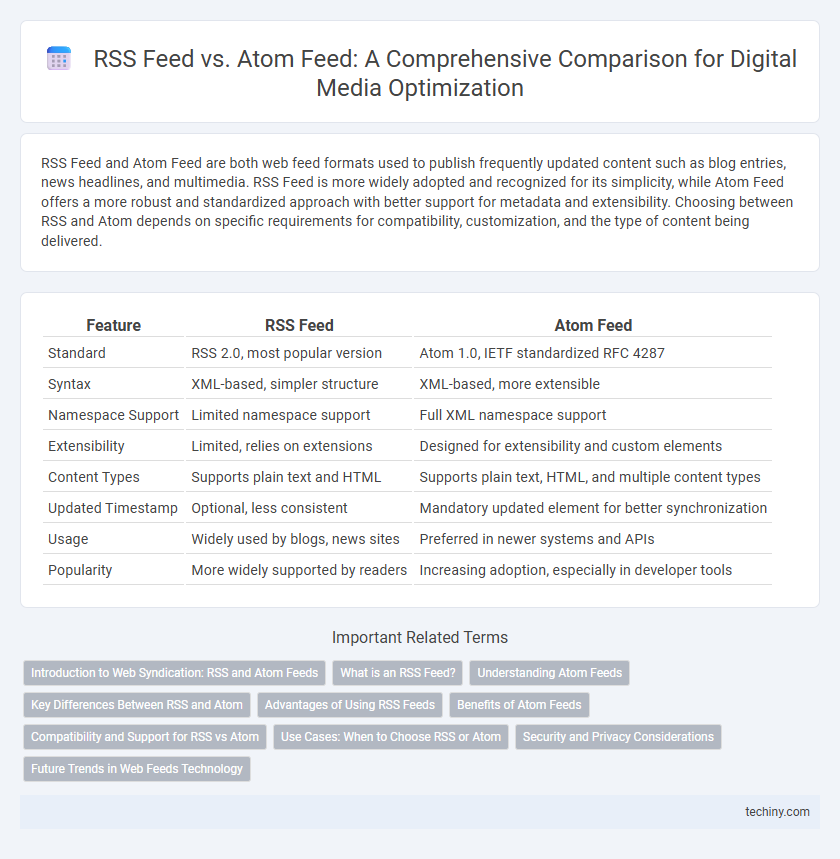RSS Feed and Atom Feed are both web feed formats used to publish frequently updated content such as blog entries, news headlines, and multimedia. RSS Feed is more widely adopted and recognized for its simplicity, while Atom Feed offers a more robust and standardized approach with better support for metadata and extensibility. Choosing between RSS and Atom depends on specific requirements for compatibility, customization, and the type of content being delivered.
Table of Comparison
| Feature | RSS Feed | Atom Feed |
|---|---|---|
| Standard | RSS 2.0, most popular version | Atom 1.0, IETF standardized RFC 4287 |
| Syntax | XML-based, simpler structure | XML-based, more extensible |
| Namespace Support | Limited namespace support | Full XML namespace support |
| Extensibility | Limited, relies on extensions | Designed for extensibility and custom elements |
| Content Types | Supports plain text and HTML | Supports plain text, HTML, and multiple content types |
| Updated Timestamp | Optional, less consistent | Mandatory updated element for better synchronization |
| Usage | Widely used by blogs, news sites | Preferred in newer systems and APIs |
| Popularity | More widely supported by readers | Increasing adoption, especially in developer tools |
Introduction to Web Syndication: RSS and Atom Feeds
RSS and Atom feeds are both popular web syndication formats designed to broadcast frequently updated digital content such as news articles, blog posts, and multimedia. RSS (Really Simple Syndication) relies on XML to structure data for easy aggregation, facilitating real-time content distribution and consumption. Atom, an alternative syndication standard, offers enhanced metadata support and extensibility, making it preferred by some publishers for richer content descriptions and improved interoperability.
What is an RSS Feed?
An RSS feed (Really Simple Syndication) is an XML-based format designed to deliver frequently updated content from websites, such as news articles, blog posts, and podcasts, directly to users or applications. It enables publishers to syndicate information efficiently, allowing readers to stay informed without visiting each site individually. RSS feeds are widely supported across numerous platforms and feed readers, making content aggregation and distribution seamless in digital media environments.
Understanding Atom Feeds
Atom feeds provide a more robust and standardized XML format for syndicating digital media content, supporting richer metadata such as authorship, categories, and updated timestamps. Unlike RSS feeds, Atom allows for better extensibility and accurate representation of feed updates, aiding content developers and aggregators in delivering timely, structured information. The widespread adoption of Atom ensures compatibility across diverse platforms and enhances user experience through improved content organization and retrieval.
Key Differences Between RSS and Atom
RSS Feed and Atom Feed are both XML-based formats used for syndicating web content, but RSS primarily supports three versions (0.91, 1.0, 2.0) while Atom offers a single, standardized version designed for extensibility and better metadata handling. RSS feeds tend to have simpler structures and limited element support, whereas Atom provides more detailed metadata, including author information, categories, and content types, enhancing flexibility for syndication. Atom is also designed to standardize web feed implementations, addressing inconsistencies found in various RSS versions, making it the preferred format for newer applications and platforms.
Advantages of Using RSS Feeds
RSS feeds offer widespread compatibility across numerous platforms and applications, ensuring content syndication reaches a broad audience effortlessly. They simplify the process of content aggregation by automatically delivering updates from multiple sources in a standardized format. Enhanced user experience is achieved through real-time notifications, allowing consumers to stay informed without manually checking websites.
Benefits of Atom Feeds
Atom feeds provide enhanced metadata support, enabling richer content descriptions and improved content management for digital media platforms. The standardized date/time format in Atom feeds ensures better synchronization and content freshness across various devices and applications. Atom's extensibility allows developers to customize feeds with additional elements, offering greater flexibility compared to RSS feeds.
Compatibility and Support for RSS vs Atom
RSS Feed remains widely compatible across most content management systems, aggregators, and podcast platforms, ensuring seamless integration and broad user accessibility. Atom Feed offers enhanced extensibility and metadata support but experiences somewhat limited adoption outside modern web applications and specialized feed readers. Developers often prioritize RSS for universal compatibility while leveraging Atom when advanced features like detailed content tagging and standardized syndication are critical.
Use Cases: When to Choose RSS or Atom
RSS feeds are ideal for users and publishers who require simple, widely supported syndication for delivering blog posts, news updates, and podcasts across various platforms. Atom feeds offer greater flexibility and extensibility, making them suitable for developers needing standardized metadata, better handling of multimedia content, or enhanced error reporting in complex applications. Choosing between RSS and Atom depends on the specific use case, distribution requirements, and the desired feature set for content syndication in digital media projects.
Security and Privacy Considerations
RSS and Atom feeds both support secure content delivery via HTTPS, but Atom offers more granular control over data inclusion, enhancing privacy by allowing finer content filtering. XML-based structures in both formats can be vulnerable to XML External Entity (XXE) attacks unless properly sanitized, highlighting the importance of secure parsing practices. Implementing authentication protocols like OAuth with Atom feeds provides stronger access control, making Atom a preferable choice for sensitive or private digital media distribution.
Future Trends in Web Feeds Technology
RSS Feed remains widely supported for syndicating news, but Atom Feed's flexible metadata structure and support for richer content formats position it as the preferred standard for emerging web applications. Future trends in web feeds emphasize real-time updates, enhanced personalization through AI-driven content filtering, and better integration with decentralized web technologies like blockchain. Developers and digital media platforms increasingly adopt Atom to leverage these advancements and improve content delivery efficiency across diverse devices and services.
RSS Feed vs Atom Feed Infographic

 techiny.com
techiny.com